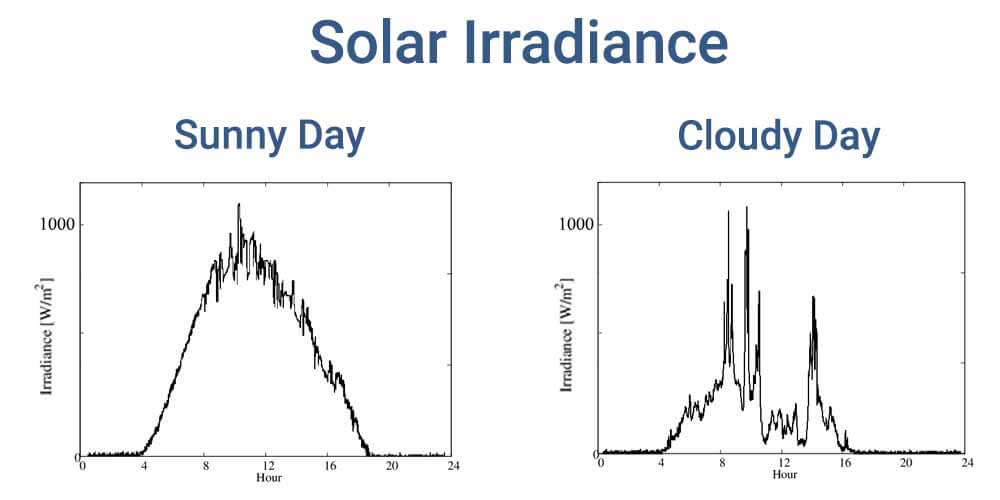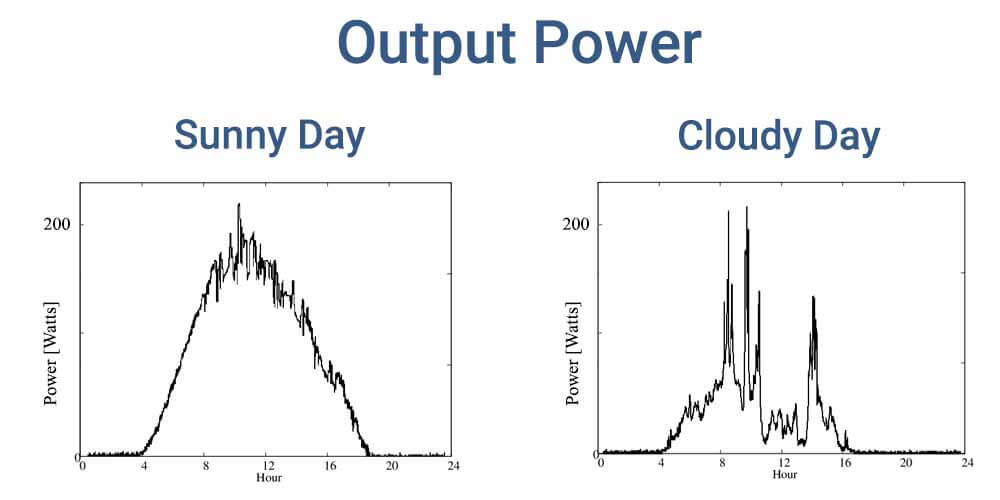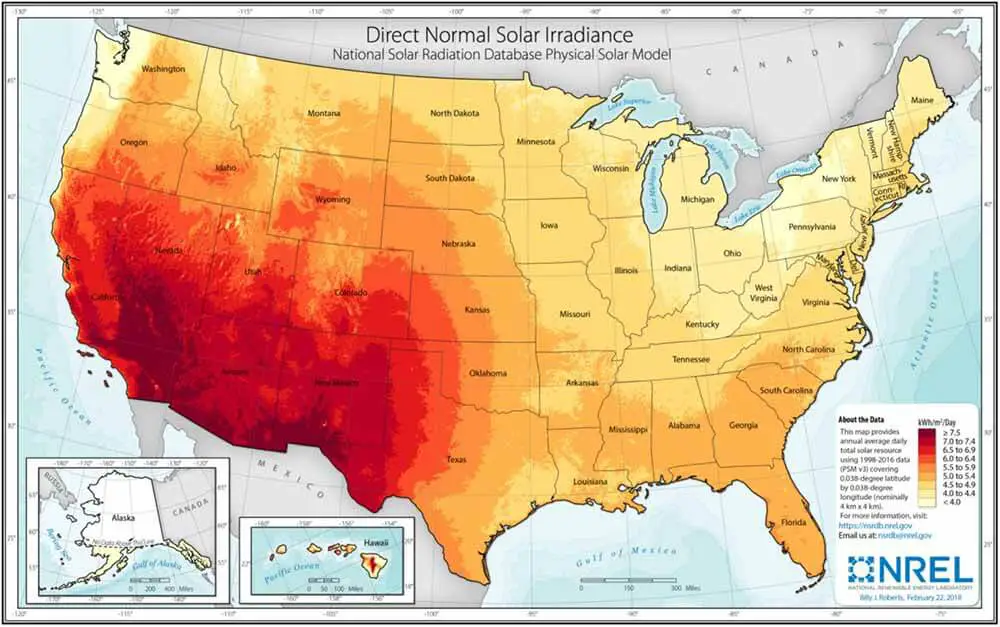In this article, we’ll see if solar panels can work on cloudy, rainy, or snowy days. And if so, we’ll discuss how well they do perform.
Do solar panels work on cloudy days
Solar panels do work on cloudy days, however, the power production will generally be less than half of what it could be on a sunny day. This is because the amount of sunlight that a solar panel receives on a cloudy day is significantly lower than it receives on sunny days.
When under the sun, a solar panel uses a combination of direct sunlight and diffuse sunlight. However, on a sunny day, direct sunlight represents most of the energy received from the sun.
Although solar panels use all the light they can get to produce power, they generally depend on direct sunlight to reach maximum output. On cloudy days, there’s essentially no direct sunlight, and the only light available for the solar panels is diffuse sunlight.
Diffuse sunlight is enough to make a difference between night and day but does not carry enough energy for the solar panels to reach their rated output.
Related: Do solar panels need direct sunlight to work
How well do solar panels work on cloudy days?
On cloudy days, depending on the thickness and density of the clouds and how consistent the weather is, solar panels generally produce between 10% and 50% of their rated output. For example, a 4kW (kilo-Watt) system that would normally produce 20kWh (kilo-Watt-hours) of energy on a sunny day would only produce 2kWh to 10kWh on a cloudy day.
In other words, a 100W solar panel can produce up to 100 Watts of power on sunny days at peak sun. On cloudy days, the same panel would only produce 10 to 50 Watts.
This is because solar panels are tested at 1000W/m² (Watts per Square Meter), which means a solar panel needs exactly 1000W/m² of solar irradiance to produce 100% of its rated output. Generally, this amount of solar irradiance is only possible on a perfectly sunny day.
For example, the following graphs compare the solar irradiance (sunlight energy) received on a sunny day vs on a cloudy day:

These graphs show the amount of sunlight energy in W/m² (Watts per Square Meter) that a ground surface receives.
You can see that on a sunny day, the amount of irradiance slowly increases in the morning until it peaks at about 1000W/m² around noon, and slowly decreases towards the afternoon and evening.
On a cloudy day, the total solar irradiance increases and decreases in the same way but with lower amounts of energy as the clouds block most of the direct sunlight.
The irradiance peaks on cloudy days are due to clouds briefly dissipating and making way for direct sunlight to hit the ground surface.
Now let’s say we set up a 200W solar panel on the same ground surface.
Since solar power production depends directly on the amount of light the panels receive, this is what the production of the 200w solar panel would look like on the same sunny and cloudy days:

On a sunny day, you can see that our 200W solar panel hits its peak output (200 Watts) at the exact time the solar irradiance reaches 1000W/m².
On a cloudy day, the solar panel only reaches its rated output when the clouds briefly allow the direct sunlight to pass through. Before that, its output maxes out at about 50 watts, which is only a quarter of what it could produce.
In more severe weather conditions, where the cloud cover is thicker, the solar panel would receive less sunlight and would therefore produce less energy.
Will I have power on cloudy days or at night?
If solar panels don’t produce much energy on cloudy days and don’t produce any energy at night, does that lead to a power outage?
The answer is no, with solar panels, you can still have access to electricity on cloudy days or at night.
This is because solar energy systems generally include some kind of energy storage.
In an off-grid system, you essentially take energy directly from the battery. In off-grid, solar panels are sized and designed to produce enough energy for 24 hours or more and their job is to keep the battery bank full.
The trick is to have enough solar power and battery storage for the worst-case scenario.
In grid-tie systems, net metering allows you to use energy from the grid when the panels are not producing enough or any energy at all, and store energy in the grid when solar panels are making more than enough. In other words, net metering lets you use the grid as a battery bank.
Battery options such as the Enphase Encharge or the Tesla Powerwall are also available for grid-tie systems. With these options, the energy produced by the solar panels is stored in a battery bank during the day and any surplus is available for use during the night.
Do solar panels work on rainy days
On rainy days, solar panels can still generate electricity. However, since the sky is generally covered in thick, dark clouds when it rains, solar panels can only produce up to about 20% of their rated output power.
For example, on an average rainy day, a 100W solar panel can only produce up to about 20 watts, a 200W panel can only produce up to 40 Watts.
As mentioned above, this is because the cloud cover does not allow any direct sunlight to pass through, and the only light available to the solar panels is diffuse sunlight.
A solar panel needs 1000W/m² of solar irradiance to produce 100% of its rated power, which is only possible if direct sunlight is available. On a rainy day, and with direct sunlight unavailable, a solar panel will only have access to 100-200W/m².
An important thing to note is that after the rain stops, you might find that dirt (soil) has accumulated at the bottom cells of your solar panel(s). If left unattended, the further accumulation of dirt on these cells might cause the solar panel(s) to stop producing power altogether.
To learn more about the effects of blocking certain solar cells on the solar panel from sunlight, please visit this link: Effect of shade on solar panels.
If you have access to your solar panels, a good idea would be to check for and get rid of any dirt on your solar panels after a rainy day.
do solar panels work in the snow?
Solar panels can work when it’s snowing, but they’ll only produce 10 to 20% of their rated output due to the thick cloud cover. However, If the snowfall is heavy enough for the solar panels to be completely covered, they won’t work at all.
The good news is that you generally won’t have to clear the snow off the solar panels. This is because the smooth glass surface of the solar panels and their inclination angle won’t let the snow stay on there as long as it would on a regular roof.
Although the accumulation of snow on solar panels can stop them from producing power, this does not mean that solar power does not work in places where it snows.
When trying to figure out if solar power is going to work out in a certain location, the most relevant question to ask is “how much sunlight does this location receive?”
The National Renewable Energy Laboratory (NREL) provides a few resources that answer this question. One of which is this map of the yearly average solar irradiance.

Click here to see the full resolution.
You can see that even in states like Colorado (where it snows a lot during winter), you get almost as much sunlight as New Mexico or Arizona.
For example, Pennsylvania, Ohio, and Michigan receive around 4 Peak Sun Hours per day (4000Wh/m² of sunlight energy per day). This amount of sunlight might not be as high as the amount of sunlight received in sunny states such as California. But it is enough for solar power to work.
4 Peak Sun Hours per day means that on average, a 100W solar panel would produce 400Wh of energy per day.
A 10kW solar system would produce 40kWh of energy per day in these locations. Which is more than enough to power the average household.
Using NREL’s PVWatts Calculator, you can even look at the amount of energy your solar panels would produce in specific months in the winter. For context, you can compare the energy value to values from the summer or to values from other locations.


